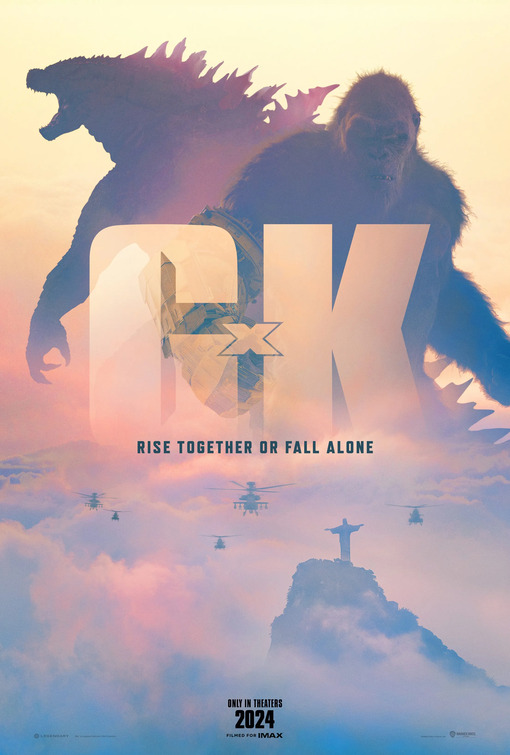
Crossovers often feel like the final frontier for franchise filmmaking, the place where long-running series go when they’ve been everywhere else, including outer space in some cases. But what comes after the crossover? It’s a question that’s rarely been seriously posed, much less answered — usually, it involves some sort of reset or reboot since it’s hard to top the novelty of seeing familiar characters share a screen. This crossroads is certainly a familiar one for Godzilla and King Kong, two titans that first came face-to-face in 1962 before going their separate ways. The King of the Monsters went on to romp through more movies and animated series across multiple continents and eras; meanwhile, Kong was reinterpreted a few times, most recently in the MonsterVerse, WB’s kaiju sandbox that allowed for a long-overdue rematch with Godzilla in Adam Wingard’s weird, wild mash-up that paid off the studio’s world-building in rousing fashion. However, an obvious question lingered as the dust settled from this confrontation: what’s next?
For Warner Brothers, the answer was simple: just give the keys to Wingard and get the hell out of the way. His response is GODZILLA X KONG: THE NEW EMPIRE, a sequel that doubles down on his vision of the MonsterVerse as a canvas to indulge his vivid imagination. If the previous film felt like him emptying the tank in a fevered attempt to squeeze all of his childhood fantasies into the monster movie of his dreams, then THE NEW EMPIRE is the equivalent of him gorging on sugar at the breakfast table before trying to recapture those dreams with his toys. It’s an unrepentantly silly but undeniably riveting testament to the notion that there’s a specific artistry to crafting blockbuster spectacle, an arena that often requires filmmakers to delicately weave a needle through a variety of tones and modes. Something like GODZILLA X KONG feels like it should be simple — just let the big lizard and giant ape smash each other — but there’s a reason crossovers are so hit-and-miss, so it’s that much more remarkable that Wingard has hit twice.
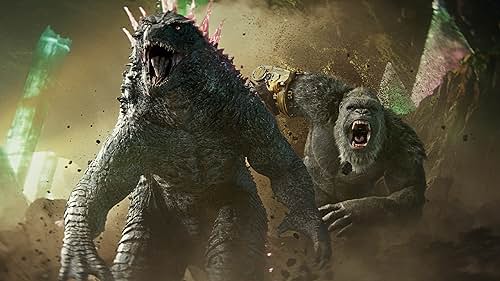
Most filmmakers in his position would likely try to top something like GODZILLA VS. KONG by spinning a more elaborate, intricate yarn; however, Wingard has resisted the temptation here by streamlining the story. This time out, it’s Kong leading the film’s narrative thrust: now back at home on Hollow Earth, he spends his days in search of other members of his species. Up on the surface, Godzilla reigns as the Alpha Titan, heavily monitored by a Monarch outfit that’s also detecting signals from down below that drive him to consume massive amounts of radiation. Those signals also seem to be inspiring strange visions and dreams in Jia (Kaylee Hottle), who feels drawn down to Hollow Earth in search of answers. With all signs pointing towards an impending showdown, Ilene Andrews (Rebecca Hall) taps conspiracy theorist Bernie Hayes (Brian Tyree Henry) and old acquaintance Trapper (Dan Stevens) to lead an expedition into the Hollow Earth, where ancient secrets are about to erupt into a conflict that could reshape all corners of the globe.
I know that sounds like quite a mouthful, but GODZILLA X KONG breezes along, effortlessly bounding from one sequence to the next as it builds towards its latest monster mash. It helps that it only features one group of humans to worry about this time, and they spend most of their time in Hollow Earth alongside Kong’s exploits. Everything below the surface meshes quite well as Wingard and company delve into Hollow Earth and its history, which ultimately holds the answer to Kong’s quest for companionship. It turns out there are more of his kind, but they’ve met with a terrible fate under the tyranny of Skar King, the film’s ultimate villain whose emergence has inspired Godzilla’s nuclear consumption on the surface. This is where Wingard and company are at their most efficient, as The King of the Monsters doesn’t require his own set of human characters this time around; instead, an anonymous collection of Monarch agents track and narrate his path across the globe, not unlike his treatment in the original KING KONG VS. GODZILLA. What’s important is the sharp sense of propulsion: like the film itself, Godzilla moves with a purpose, with every encounter pointing toward the big brawl awaiting at the film’s climax.
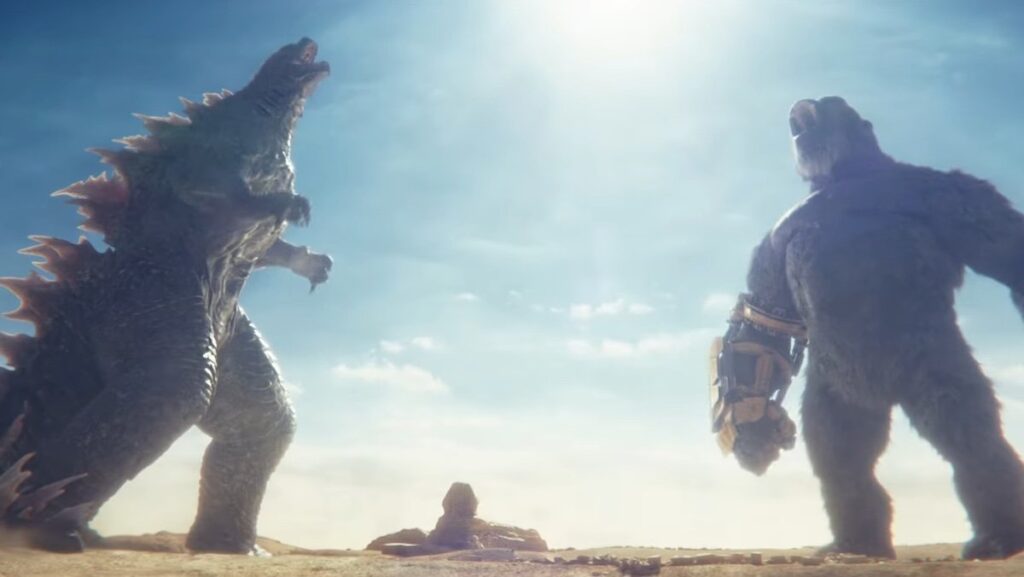
Wingard’s nod toward that classic crossover isn’t a fleeting homage either because GODZILLA X KONG is an invocation of Showa-era delirium. It’s bursting with the sheer imagination that makes the best films of that era so compulsively watchable, particularly in the way it delves even further into Hollow Earth. Where the previous film scratched this realm’s surface, this one plunges headlong into this fantastical ecosystem, where various beings and creatures roam the land, the skies, and beyond, making it an ideal staging ground for an abundance of monster brawls and the deepening of this world’s already bizarre mythology. At no point does Wingard shy away from the wild possibilities offered by this premise: from frame one, he indulges any and every chance to introduce some strange monster or stage some kind of fight or chase sequence. He understands that the appeal of this particular type of kaiju film is the monsters, and he’s unrepentant about embracing them to the point where they’re unequivocally the film’s protagonists and antagonists.
GODZILLA X KONG is the type of film you imagined while you suplexed your action figures during Saturday morning cartoons as a kid, right down to the way your mind would develop the intricacies of its mythology. It not only boasts all of the wild theatrics of childhood fantasies but also the emotional investment — sure, it’s kid’s stuff, and it’s a very silly movie, but there’s a sense that it all matters. With its fanciful treatment of its title characters, GODZILLA X KONG is not serious business in the conventional sense, but it’s also not a complete lark because Wingard’s affection for this universe and its characters is evident in the way he thrusts the monsters into the spotlight, effectively allowing them to carry the film, with the humans in true supporting roles.
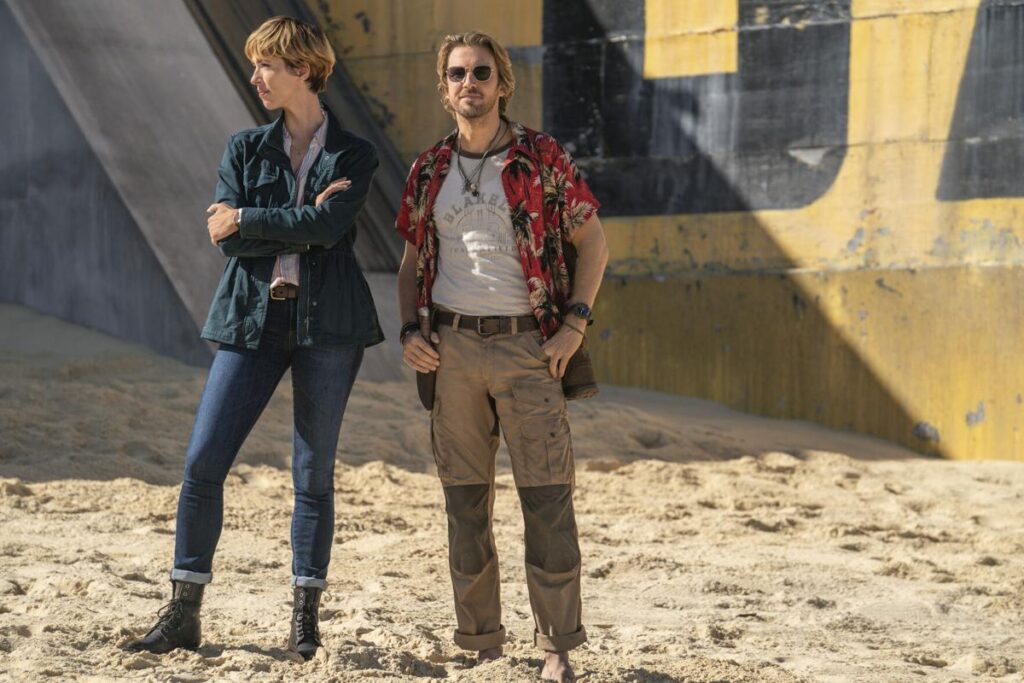
A couple of months ago, I was privileged to interview Wingard about this project, and he insisted throughout that he saw this film as an opportunity to experiment and stretch the boundaries of this genre’s narrative conventions. The final product bears this out and then some, as long stretches of GODZILLA X KONG capture the monsters’ existence in an almost anthropological sort of way. We’re privy to Kong’s daily life, which entails fending off other creatures and disposing of them with traps; meanwhile, Godzilla has taken a liking to nestling in the Roman Colosseum, much to the dismay of the local authorities. Eventually, Kong bonds with Suko, a young ape who defects from one of the Skar King’s hunting parties before leading his new protector to a horrific underground lair, where Kong’s kind is enslaved along with an ancient titan. All of this is so tremendously absorbing that you forget you’re watching a cartoon without conventional dialogue, which is not only an obvious testament to the incredible effects team but to just how fully realized Wingard’s vision of this world is. In 2005, Peter Jackson and WETA’s vision of Kong was so groundbreaking and astounding that you had to take notice of how seamlessly integrated it was; nearly 20 years later, these kinds of creatures populate movies so frequently that we sometimes lose sight of how incredible it is. GODZILLA X KONG recaptures that sense of awe and wonder by trusting audiences to invest in these beasts as actual characters instead of simply treating them as action figures to be smashed together.
Not that Wingard resists that urge: of course something like GODZILLA X KONG exists as an excuse to stage the wildest, kaiju-sized monster mash imaginable, and it absolutely delivers on this front. The screenplay scatters several thrilling confrontations throughout the film, giving its title characters ample opportunity to smash other creatures before briefly throwing down with each other once again before an enormous climactic brawl that’s essentially a battle royal on Hollow Earth. Most of this is familiar stuff, with the giant, godly monsters laying waste to cities, a sight that’s become so commonplace that you’d be numb to it if Wingard didn’t spice up the action with some inventive, entertaining choreography that’s been inspired by professional wrestling. The action sequences of GODZILLA X KONG are a reminder that a familiar refrain can still soar with the right grace notes, and Wingard practically shreds a guitar solo down the stretch when his monstrous menagerie clashes in a zero-gravity environment, allowing the creatures to defy the laws of physics as they careen into each other like pinballs. It’s a true through-the-looking-glass moment that reverses the kaiju genre’s normal impulses to exploit its monsters’ enormity against a human scale; here, Godzilla, Kong, and the whole gang become weightless pawns, flung around by the capricious whims of Hollow Earth’s unforgiving landscape in a brilliant sequence that speaks to the gonzo effort on display here.
I understand how all of this might sound exhausting or even somehow blasphemous, especially in the wake of GODZILLA: MINUS ONE, a reboot that recaptured the primal awe and terror of this genre by deeply investing in the human dimension. I might even understand the urge to assume this American take completely misunderstands this genre. However, I’d implore the critics to consider the eclectic nature of this genre, not to mention the Godzilla franchise in particular: for the past 50 years, we’ve had grim, somber variations on the theme settling alongside movies where Godzilla executes a flying kick. There’s room for all sorts at the table, and, incredibly, we’ve been lucky enough to enjoy exemplary riffs on both ends of the spectrum with SHIN GODZILLA, MINUS ONE, and even the 2014 Gareth Edwards take that introduced the MonsterVerse. Yes, GODZILLA X KONG is a far cry from that film’s measured, suspenseful approach; however, it must be noted that the original 1961 crossover was just as far removed from the original GODZILLA.
With GXK, we return to an eternal truth: at the end of the day, we love watching these big boys bash, even if it comes at the expense of that human element (though I’d argue that Stevens and Henry are delightful comic relief here, while Hall and Hottle provide a solid emotional backbone). For the past 20 years, I’ve defended FREDDY VS. JASON from similar criticisms regarding a slack plot and weak characters, and I’m fully prepared to lead the charge for GODZILLA X KONG, a film that absolutely nails its most important aspects while remaining reverent enough to the material that it never feels like an elaborate joke. Ultimately, I can’t hate a movie where giant monsters ride even bigger monsters into battle and Godzilla suplexes King Kong into an Egyptian pyramid before taking refuge in the Roman Colosseum. As another great warrior once bellowed in that hallowed arena, “Are you not entertained?”
Tags: Adam Wingard, Alex Ferns, Antonio Di Iorio, Apes, Australia, Ben Seresin, Brian Tyree Henry, Dan Stevens, Fala Chen, Giant Monsters, GODZILLA, Gorillas, Jeremy Slater, Josh Schaeffer, kaiju, Kaylee Hottle, king kong, Legendary Pictures, Monsters, mothra, Rebecca Hall, Simon Barrett, Skar King, Suko, Terry Rossio, Toho Co., Tom Holkenborg, Warner Bros. Pictures

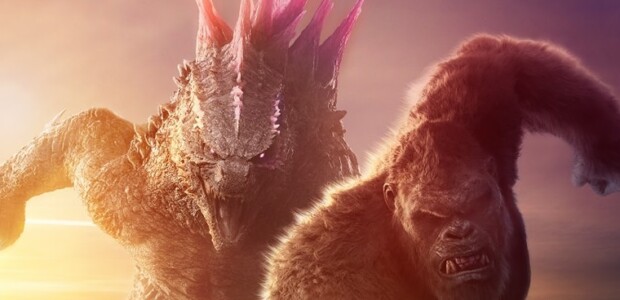

No Comments